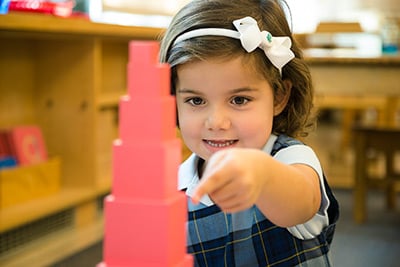The first few years of life are perhaps the most crucial part of the education process. Your child’s brain is forming 700 new neural connections every second—there’s no other time in life when their brain will be so open to learning or so influenced by their learning environment.
Harvard’s Center on the Developing Child calls this stage in brain development a time of “early plasticity.” That means your child’s brain is rapidly absorbing the stimuli around to set up the framework for how it will learn and react for the rest of their life. After the first five years of life, the brain loses its plasticity and it becomes much harder to influence how your child learns.
For this reason, choosing your child’s preschool could be one of the most important decisions that you make about their education. You want to find a program that lays a foundation for a lifetime of passionate learning, one that will nurture and guide your child as they set off on their educational journey.
At Whitby, a key reason our preschoolers are excited to attend school and love learning is our inclusion of the Montessori education in our curriculum.

As a parent, you’ve probably heard about how the Montessori preschool helps children thrive. If you’re trying to decide if this type of education would benefit your own child, read on. We’ve outlined the key characteristics of a Montessori classroom and explain how those characteristics set children up for a life of learning.
7 Key Characteristics of a Montessori preschool:
Characteristic #1: Classrooms that include children of different ages.
The multi-age classroom is a hallmark of a Montessori preschool that gives children many unique learning opportunities. Younger children naturally learn by emulating children who are older than themselves, and the Montessori classroom takes advantage of it. Younger children watch their older peers model how to participate in the classroom learning activities, how to engage with the teacher and their peers, and how to move from one activity to the next.
The older children also benefit from the multi-age classroom. They get an opportunity to practice their leadership skills and develop empathy as they help younger students learn. Older students get the opportunity to act as mentors and reinforce their own learning as they help the younger children gain skills.
Want to learn more about multi-age classrooms? At Whitby, our Stepping Stones program includes children aged 18 months through 3 years old. In our Lower School, first and second graders study together in a multi-age classroom. Learn more about our Montessori preschool and private elementary school programs.
Characteristic #2: An environment that emphasizes responsibility and self-discipline
When a child takes part in a student centered education, they discover their own path to learning (with guidance from their teachers.) This helps children learn about responsibility: they need to learn how to work within the framework and schedule of the classroom, for instance, and how to use their time constructively. They even learn to take responsibility for helping younger children in the classroom who may be struggling with a concept they themselves have already mastered.
Another aspect of responsibility is self-discipline. Children naturally want to feel that they belong in a group. They want to have friends at school, and they want to do well academically. No child wants to fail.
When a child knows they are responsible for their own behavior and their own success in learning, they feel more motivated to regulate their own behavior. In a Montessori classroom, the more self-discipline a child exhibits, the more they are rewarded with freedom to pursue learning the way they enjoy most.

Characteristic #3: A curriculum that emphasizes independence.
The traditional learning model says to children, “Do what you’re told when you’re told to do it.” Then after twelve years, the expectation is that children will become successful, independent adults. That doesn’t make sense. Independence, like every other aspect of adult life, is learned little by little in growing increments, with each learning milestone supporting the successful development of the next.
In a Montessori preschool, children learn how to be self-directed. They choose the activities that most appeal to them and they are free to explore these activities at their own pace. Sometimes they make mistakes, but that is the beauty of independence. Children have the ability to learn in a relatively risk-free environment and to grow from their mistakes. As a result, this freedom and sense of responsibility helps children feel supported and empowers them to become creative and independent adults.
Characteristic #4: An orderly classroom with prepared workstations.
In the Montessori classroom, each teacher prepares a wide range of learning activities well before the children arrive. During a “work cycle” in a Montessori preschool, children independently choose one of those learning activities to pursue during that class. Then they’re given an uninterrupted period of time to complete that activity and return materials to their proper place at the end. The Montessori work cycle teaches children to focus their attention and learn how to complete a task with minimal help. As a result, children feel a sense of accomplishment with each work cycle they successfully complete.
Workstations in a Montessori classroom are designed specifically to provide differentiated learning opportunities that appeal to many learning styles. At some workstations, preschoolers run hands-on experiments, while others challenge children to work together as a group to solve the learning activity. Other workstations will be designed for children who prefer to learn independently. When children come into the classroom, they are free to explore the workstations and choose a learning activity that most appeals to them on a given day. Since all the activities represent valuable learning opportunities, the children learn no matter which activity they choose.
Characteristic #5: A teacher who guides rather than directs.
In the Montessori classroom, you will not see a teacher at the front of the classroom lecturing. The focus of Montessori classes is on the students, not the teacher. Educators are not there to provide students with information they must memorize. Instead, the teachers guide and support children as they pursue learning on their own. Teachers contribute by designing well-thought-out learning opportunities that encourage children to learn, and then guide and support children as they participate in those learning exercises.
Characteristic #6: Parents who understand and support the learning process, and who are involved in their child’s education.
In the Montessori classroom, parents are recognized as valuable partners in their children's’ education. Montessori teachers know that parental involvement is key to a child’s success. As a result, they create opportunities to encourage parents to come into the classroom, observe and interact with their children.
At Whitby, we also encourage parents to volunteer at the school, attend parenting workshops and create a community with other parents. We’ve found that the more parents become part of the Whitby community, the more excited their children are about learning.
Characteristic #7: An atmosphere of mutual respect.
The teachers in the Montessori classroom understand that each child has an innate desire to learn when given the opportunity to do so in a way that fits their strengths and learning style. Children in the Montessori setting also learn to respect their teachers and their peers. They come to understand that everyone—educators and students alike—is part of a community that supports each other while they learn together. While the teacher works as a facilitator, the students also work together in partnership as they explore the learning opportunities all around them.
Creating An Environment Where Children Thrive
At Whitby, we believe in creating a preschool environment where children grow physically, emotionally and academically. Every day we see students light up as they explore classrooms full of learning opportunities. By combining the Montessori preschool with the International Baccalaureate program at Whitby, we create an environment that inspires children to love learning.
Want to see one of our classrooms in action? Schedule a tour of campus.



